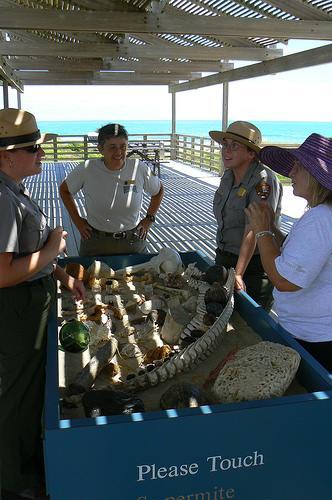I believe the role of interpretation in park resource management is of utmost importance. When a skilled interpreter can reach an audience with his message, visitors can walk away from the park visit with a deeper understanding and appreciation for the resource the park service is trying to protect. This is why I worry about the trends I see in the parks which belittle the role of the professional interpreter.
It is not uncommon to read about electronic rangers arriving in the parks -- computer controlled handheld devices with GPS installed, available for rent. We are beginning to see pay-to-participate interpretive programs offered by the Park Service in some areas. And in other areas, professional interpreters are being replaced by concessionaire operated bus tours with pre-recorded programs played over the speaker system. I have great concern that the role of interpreter is coming to be understood as one of simply "tour guide", or worse, an entertainment act.
I am pleased to share with you an article which appeared in the San Antonio Express-News. The author of "a Ranger's lessons", discovers first hand how powerful an interpretive program can be when given by an experienced, knowledgeable park ranger to an intimate group of curious visitors.
Have you been on a program like this? The Padre Island National Seashore interpreter, William "Buzz" Botts, starts with the cool factor of the beach environment.
[He began his talk] at the "Beach in a Box," a "touch table" filled with sand and a collection of items gathered from the beach, each of them presenting a different story: a pelican skull, a dolphin spine and a green glass globe, which turned out to my surprise to be an antique fishing float, and a piece of fulgurite, which is a petrified chunk of sand melted by a lightning strike on the sand that cooled into a column of stone.
Once the unique nature of the Padre Island environment has been revealed, time to move into protection mode, reveal that this special place has some issues that have to be addressed.
"When they do necropsies of sea turtles — which is like an autopsy — a common feature is the plastic they find in their gut. Then there are the bite marks we find in these plastic bottles, which is evidence of feeding by sea turtles. They probably think it's a jellyfish."
Unfortunately for the professional interpreter, it is next to impossible to quantify the success of the program. How many people after having seen this program will retain the information and alter their behavior to better protect the park resource? Who can say? For this article though, the author leaves us a final thought which suggests the ranger's program changed her outlook of the beach.
Later, as I buy ice cream from the ice cream truck on the beach, the lady apologizes for the seaweed that Hurricane Dean had deposited. I told her the seaweed didn't bother me much; it's part of nature — but to see the plastic strewn around was the problem.
Pretty cool. Would this ranger's interpretive program been as successful if it had been delivered over an iPod? My sense is, no it wouldn't have been. There is just something special that occurs when people talk with people. It is hard to reproduce that level of communication electronically.




Add comment